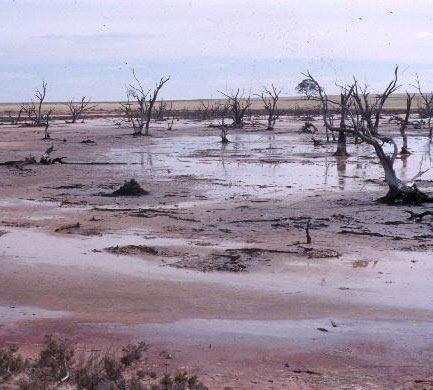Background
When the drought breaks
It's raining at last! Is this the end of the drought?
To the uninitiated, the first good fall of rain after many months or years of drought means the drought is over. However, defining the end of a drought is not that simple. See www.bom.gov.au for more detail.
Just as the drought itself is a disturbance that gradually increases over time, recovery can also be a long and complex process for freshwater ecosystems and their biota. Scientists refer to drought as a ramp disturbance ... and we know a lot more about the trip up the ramp, than the way down, i.e. the recovery.
Nonetheless, it is essential that, when designing post-drought management plans, we consider options to enhance the recovery of affected ecosystems and also to identify factors that might impede it.
Factors and issues
The extent and rate of recovery depend on many factors including the nature of the drought, the availability of refuge habitats and exactly how the drought breaks - by a flood or more gradually.
In broad terms, for good recovery from drought, we need a suite of reactive and proactive strategies ... before the drought, during it and, of course, after it. The aim is for these collectively to help to sustain the resistance and resilience of aquatic plants, animals and ecosystems to drought ... and so facilitate their eventual recovery.
To ensure recovery from more frequent, more prolonged and more intense droughts, such as those predicted under climate change scenarios, we need continuing investment in efforts to understand how river ecosystems are affected by, and recover from, drought. This requires better knowledge of both ecological processes and species.
Issues to address in relation to recovery could include:
- local species extinctions,
- recovery of algae, larger aquatic plants, and other vegetation,
- pathways of recolonisation (and barriers to it),
- lag effects in population recovery, and
- the structure of new communities or assemblages of species.
There can be complicated interactions after drought. Take the impact of the first rains. When a drought breaks, extra nutrients may enter lakes with the initial runoff flows. These nutrients can trigger outbreaks of toxic microalgae and cyanobacteria, better known as blue-green algae. These include Prymnesium parvum, Anabaena circinalus and Cylindrospermopsis raciborskii - all species producing toxins that can have multiple ecological effects, including illness and death in gilled fauna such as fish.
Renewed efforts to restore our human-affected aquatic ecosystems and, where possible, to provide them with much more generous environmental flows should be our first priority when the drought breaks. Only then can we anticipate the next drought with greater confidence that our remarkable ecosystems, with their unique flora and fauna, will be in better shape to survive the trauma, bounce back from the experience, and to continue to provide the goods and services we depend on.
Learning from drought
When Australia is drought-stricken, we should try and see it as a golden opportunity to learn from the experience - that is, to gain knowledge from natural drought in unregulated systems and compare the ecological responses to those seen in droughted and regulated rivers.
We have, in effect, a vast laboratory in which to explore the ways in which Australian rivers respond to severe climatic, hydrological and human disturbances.
Keywords:
Topics:
| Principels for protecting aquatic biodiversity | View Frequently Asked Questions | View Bibliography |
| Recovery from drought | View Frequently Asked Questions | View Bibliography |

